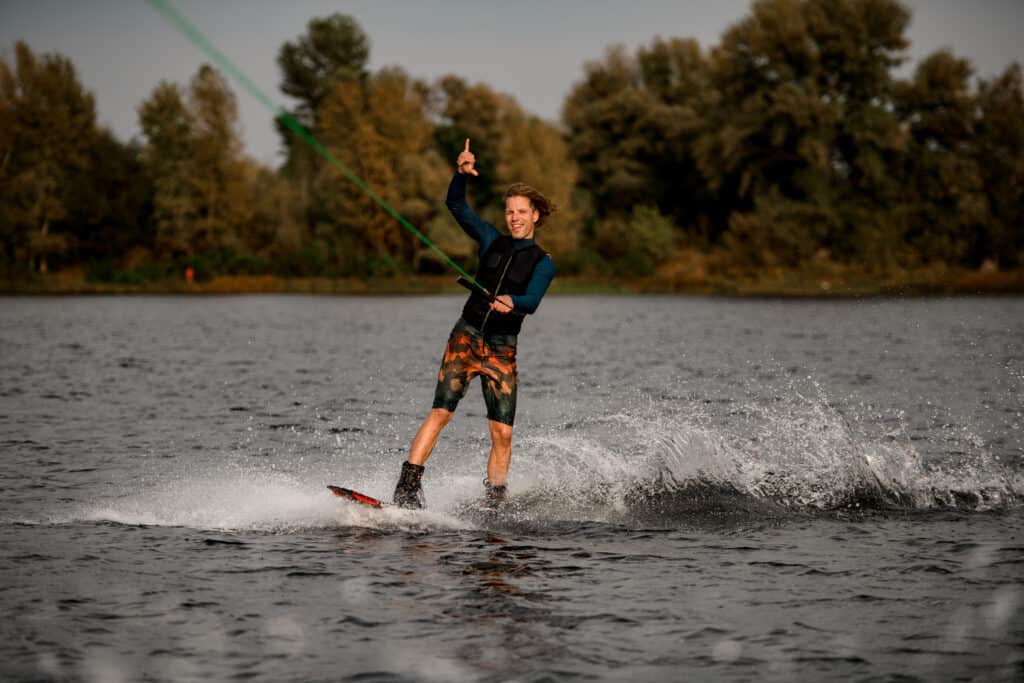If you’ve visited this blog before, you’ll know the whole idea is to push myself to try new things. I enjoy the feeling of being out of my comfort zone and being a beginner again, and I’m hoping that also inspires you to try something new.
On my honeymoon in 2021, I was fortunate that the hotel we were staying at had motorised water sports included. This meant in between relaxing and exploring the sights, I could start to learn how to wakeboard as well as enjoy banana boat and rubber ring rides. This was my first experience of wakeboarding, although, I am able to snowboard which is a big advantage. There are some key differences but the fundamentals of how you steer are the same, using your toe and heel edge. Unfortunately, in order to be able to use those snowboarding skills you have to be able to stand up first.

Getting Set Up
As we were by the sea I was going to learn by being pulled by a boat. There is a big difference between wakeboarding behind a boat and being on a looped cable, and getting set up is one of them. Once you get onto the boat with your buoyancy aid on you’ll get whisked away from the shore to get started. You’ll then jump into the water and be handed the wakeboard. Now you’ve got to get you’re feet into the wakeboard whilst in the water, which means lying back as much as you can and levering your feet in. The foot moulds are made of rubber which when wet don’t let your feet slide very easily so it can be a bit of a struggle.
The rope that connects you to the boat has a small handle on the end which is the next thing you get passed and then you’re pretty much set. The boat will slowly start to pull the slack out of the rope and you have to make sure it’s going straight between your feet. This means you get pulled up straight on top of your board rather than twisting you around.
Standing Up
Standing up is the first big obstacle to learning to wakeboard. When learning, the boat will start to accelerate slowly, this will pull any remaining slack out of the rope and start to pull you forward. This is the crucial moment and it’s important to be patient. At this point, you have to keep your board sideways. This acts like a brake and means your body gets pulled up out of the water. That means you’re fighting against the boat and this builds tension in your grip and arms as the boat speeds up. As you start to get pulled up out of the water this is the time to transition the board from sideways, to facing forwards. The patience comes from waiting until you’re almost up to stand. Any earlier and there won’t be enough tension on the rope for you to turn forwards. This process happens in just a few seconds which is why it’s really easy to rush, but smooth movements are most likely to be successful.
If you do fall over, make sure to let go of the handle, otherwise, you continue getting pulled along by the boat. It’s likely to happen a few times when you’re learning, but don’t panic, you won’t get stranded in the water. Your buoyancy aid will keep you afloat so turn over onto your back and get ready for your next go. The boat will circle around and come back to collect you, they’ll pass you the handle and you have another go.
You should have a natural way of boarding, left foot forward is regular and right foot forward is goofy. When wakeboarding in order to stop your front edge from catching any waves in the water, your weight is shifted onto your back foot. I board goofy and something I’m currently working to improve is my regular riding.

Standing up is the first big hurdle to get over with wakeboarding and it is a rather big one. It takes practice and resilience but is so worth it when you nail that start and begin cruising along.
Cruising
Once you get past the first hurdle of standing up, you’ll get the chance to cruise around behind the boat. You want to stay nice and relaxed with your knees slightly bent. With your knees nice and relaxed they act like shock absorbers, meaning you are less likely to be impacted by any waves or swells in the water. If your legs are locked out straight even a small swell may cause you to fall over.
To begin with, the boat is going to be heading in a straight line. Your weight is going to be shifted more towards your back foot, and you want your weight centralised in the middle of your feet (front to back). This helps to avoid catching either your toe or heel edge.
Whilst the wake of the boat spreads out in a V-shape meaning you don’t get fully impacted when travelling in a straight line, the water has still been churned up and so isn’t as smooth as the outside of the wake. You can see that in the video below as the white water is churned up and the water outside stays flat.
With practice, cruising in a straight line will become more comfortable and require less thought and you’ll be able to enjoy the feeling as you rush along, spray coming up from your board and the wind rushing by.
Turning
Now we’re up on our feet and heading in a straight line, it’s time to understand how to make the board turn beneath you. As I mentioned earlier, it’s the same as lots of other board sports such as snowboarding, surfing and skateboarding. You use your feet to control the toe (front) and heel (back) edges to turn left and right.

Again, smooth movements are really important and help to keep your upper body nice and stable. This becomes really important as your upper body and head are relatively heavy, so any big movements there can cause your edges to dig in. Jerky movements also cause the edges to dig in and it’s much more likely to happen with straight legs, so remember to keep nice soft knees.
To do a toe-side turn, you shift weight onto the toe edge, which contacts the water, increasing the resistance and slowing that side of the board down. This means it is going slower than the heel side of the board and you’ll turn towards your toes. This is exactly the same on the heel side, as you move more weight onto the heel edge, it slows down and the board will turn to the heel side.
These movements need to be nice and progressive, you want to transition your weight from the middle of the board onto each edge. Being smooth allows control over how much edge you use and therefore how aggressively you turn. In order to shift your weight your toes are critical. Either by pushing down through the balls of your feet to move onto your toe edge. Or by lifting them up so they pull the toe edge out of the water which forces your weight onto the heel edge.
Riding the Wake
When riding straight behind a boat, the wake disrupts the surface which creates additional bumps you have to deal with. This is one key difference between a boat and a cable as there is very little wake on a cable, only what other riders produce. In order to cope with those bumps having soft knees is really important allowing you to absorb the bumps through your legs. As your skills improve, the wake can be used as a jump to get airtime and perform tricks.
These turns are much simpler behind a boat than on a cable because they complete a smooth arc. A cable creates a loop, but it is a series of straight lines, which means that each of the corners is an angle rather than a smooth arc. When you get to each corner the cable pulls in a different direction instantly which means you have to prepare for turns in a totally different way.
Conclusion
Wakeboarding behind a boat is so much fun, it can be tough to get started as there is a fairly high barrier to getting started. However, once you make progress and get stood up, it’s an experience that is so enjoyable. I hope this article has given you some insight and removed some of the unknowns of wakeboarding but this is just the first step. Now it’s time to get down to your local watersports centre to give it a go. The community is so welcoming and the coaches will give you specific learning points to think about at each stage.
